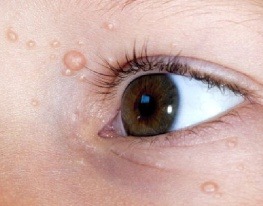About Us

Molluscum contagiosum
Molluscum contagiosum is a common contagious viral skin infection. They appear as small, flesh colored or pearly, dome-shaped clustered growths with a pit in its center. On squeezing, they pop out a white solid ball-like tissue. Molluscum commonly affects children, although it may be seen in adults as well. The lesions can occur anywhere but are most common on the face and eyelids. In adults, molluscum over the genitals or thighs may indicate a sexual route of transmission. Molluscum can also be transmitted from one area of the body to another by self-contamination. The virus can enter through small breaks in the skin or hair follicles. It does not affect internal organs. It is not accompanied by fever or weakness.
Molluscum are acquired by sharing towels, bath sponges, from wrestling and public pools. Molluscum is also more common in tropical climates. Molluscum lesions are larger, more severe and extensive among those with compromised immunity, e.g. HIV. It is also more common among atopics (individuals with eczema, asthma and/or hay fever, or a hereditary tendency for the same).
In up to 70% of all cases, Molluscum is self- limiting. The lesions turn red and inflamed just before they disappear of their own accord. However, your dermatologist will prefer to treat them as they are contagious, cosmetically undesirable, and because spontaneous resolution may take up to 6 months.
There are various treatment options available. Treatment works better when there are only a few lesions. The lesions can be frozen with liquid nitrogen or removed with a sterile needle. Since these methods are painful, they are reserved for adult patients.
In children, mollusca are treated using creams like imiquimod or tretinoin. Caustic preparations are best avoided as they burn the skin and leave marks. Infection with molluscum virus does not provide any immunity against re-infection in the future.

